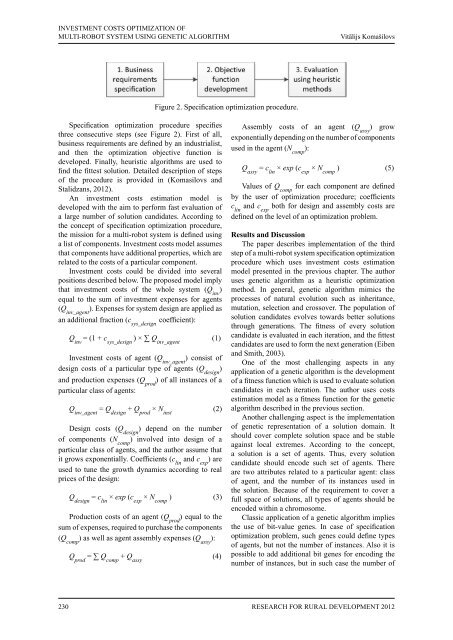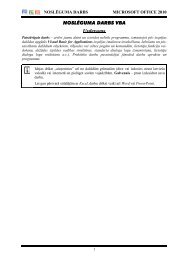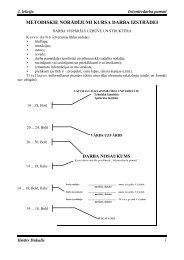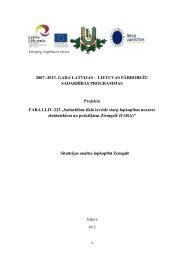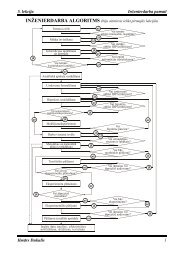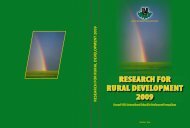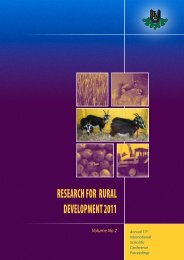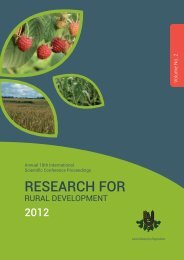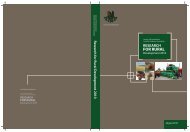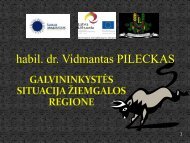LATVIA UNIVERSITY OF AGRICULTURE - Latvijas ...
LATVIA UNIVERSITY OF AGRICULTURE - Latvijas ...
LATVIA UNIVERSITY OF AGRICULTURE - Latvijas ...
- No tags were found...
Create successful ePaper yourself
Turn your PDF publications into a flip-book with our unique Google optimized e-Paper software.
INVESTMENT COSTS OPTIMIZATION <strong>OF</strong>MULTI-ROBOT SYSTEM USING GENETIC ALGORITHMVitālijs KomašilovsFigure 2. Specification optimization procedure.Specification optimization procedure specifiesthree consecutive steps (see Figure 2). First of all,business requirements are defined by an industrialist,and then the optimization objective function isdeveloped. Finally, heuristic algorithms are used tofind the fittest solution. Detailed description of stepsof the procedure is provided in (Komasilovs andStalidzans, 2012).An investment costs estimation model isdeveloped with the aim to perform fast evaluation ofa large number of solution candidates. According tothe concept of specification optimization procedure,the mission for a multi-robot system is defined usinga list of components. Investment costs model assumesthat components have additional properties, which arerelated to the costs of a particular component.Investment costs could be divided into severalpositions described below. The proposed model implythat investment costs of the whole system (Q inv)equal to the sum of investment expenses for agents(Q inv_agent). Expenses for system design are applied asan additional fraction (c sys_designcoefficient):Q inv= (1 + c sys_design) × ∑ Q inv_agent(1)Investment costs of agent (Q inv_agent) consist ofdesign costs of a particular type of agents (Q design)and production expenses (Q prod) of all instances of aparticular class of agents:Q inv_agent= Q design+ Q prod× N inst(2)Design costs (Q design) depend on the numberof components (N comp) involved into design of aparticular class of agents, and the author assume thatit grows exponentially. Coefficients (c linand c exp) areused to tune the growth dynamics according to realprices of the design:Q design= c lin× exp (c exp× N comp) (3)Production costs of an agent (Q prod) equal to thesum of expenses, required to purchase the components(Q comp) as well as agent assembly expenses (Q assy):Q prod= ∑ Q comp+ Q assy(4)Assembly costs of an agent (Q assy) growexponentially depending on the number of componentsused in the agent (N comp):Q assy= c lin× exp (c exp× N comp) (5)Values of Q compfor each component are definedby the user of optimization procedure; coefficientsc linand c expboth for design and assembly costs aredefined on the level of an optimization problem.Results and DiscussionThe paper describes implementation of the thirdstep of a multi-robot system specification optimizationprocedure which uses investment costs estimationmodel presented in the previous chapter. The authoruses genetic algorithm as a heuristic optimizationmethod. In general, genetic algorithm mimics theprocesses of natural evolution such as inheritance,mutation, selection and crossover. The population ofsolution candidates evolves towards better solutionsthrough generations. The fitness of every solutioncandidate is evaluated in each iteration, and the fittestcandidates are used to form the next generation (Eibenand Smith, 2003).One of the most challenging aspects in anyapplication of a genetic algorithm is the developmentof a fitness function which is used to evaluate solutioncandidates in each iteration. The author uses costsestimation model as a fitness function for the geneticalgorithm described in the previous section.Another challenging aspect is the implementationof genetic representation of a solution domain. Itshould cover complete solution space and be stableagainst local extremes. According to the concept,a solution is a set of agents. Thus, every solutioncandidate should encode such set of agents. Thereare two attributes related to a particular agent: classof agent, and the number of its instances used inthe solution. Because of the requirement to cover afull space of solutions, all types of agents should beencoded within a chromosome.Classic application of a genetic algorithm impliesthe use of bit-value genes. In case of specificationoptimization problem, such genes could define typesof agents, but not the number of instances. Also it ispossible to add additional bit genes for encoding thenumber of instances, but in such case the number of230 Research for Rural Development 2012


